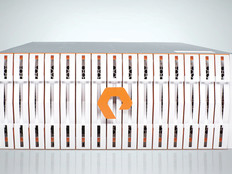The Difference Between Aggregating Virtualization and Functional Virtualization
Storage virtualization can be confusing to potential buyers because the term encompasses two distinct types of products — aggregating virtualization and functional virtualization — says Gene Ruth, Gartner’s research director for storage:
Aggregating Virtualization
With this type of solution, companies purchase a virtualization “appliance” that sits on top of an existing multivendor storage environment, consolidates the various storage arrays and aggregates them into a single environment, making it easier to allocate and manage storage resources.
According to Ruth, users who go this route gain the benefits of storage virtualization — including thin provisioning, auto-tiering and snapshots — without having to migrate their existing storage to a new solution. This solution is right for firms that are not ready to pull the plug on existing investments or that, for whatever reason, need to continue using multiple storage systems.
The appliance “creates a common administration point, a common place from which to do provisioning of storage resources,” Ruth says, noting that the aggregating appliance can be a transition technology as companies move over time to standardize on a single storage virtualization solution or as they consider migrating to a storage as a service cloud paradigm.
On the negative side, the aggregating virtualization approach doesn’t lessen the storage footprint (and actually adds another device to the mix), so while the company gains virtualization functionality and administrative simplification, it still has to bear the operational and energy costs associated with running numerous back-end storage systems. What’s more, the appliance will actually hide the features of more modern disk arrays, so a company loses out on the benefits of those investments.
Functional Virtualization
With this type of product, a company buys and standardizes on a single virtualized storage solution, effectively gaining all the features of virtualization, including thin provisioning, auto-tiering and snapshots, and an end to multisystem storage sprawl.
Companies that choose this approach decommission their existing storage systems. But Ruth says that this type of storage virtualization system — especially when used in concert with virtualized servers — is often ideal for small and medium-sized businesses because it can truly simplify the storage function and offers significant improvements in administration and operational costs as well as system performance. “It’s a good way to make a very economical storage and server and compute environment,” he says.







